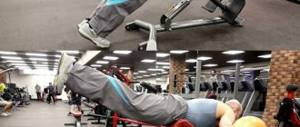Good tone and elasticity of the calf muscles is not only the ability to move freely over long distances, but also reduces the risk of inflammatory processes in the ankle joint and superficial veins of the leg (varicose veins).
Stretching exercises
To make your legs not only beautiful, but also healthy, it is not enough just to load your muscles. You should devote 10% of your strength training time to stretching. Exercises to stretch the calf muscles can be done at home.
What are the benefits of stretching?
During tonic and clonic tension, muscle fibers contract. With constant tonic load, the striated muscle fiber lengthens, loses volume, but its strength and endurance increase. There is no definitive data on the speed of contraction; it all depends on the type of training.
In clonic tension, when contractions are frequent and short-lived, the fiber shortens and becomes larger in volume. This effect is especially visible if the load is given every other day and with low weight.
An increase in muscle volume gradually leads to circulatory failure or mechanical narrowing of blood vessels. This results in a large number of stress fractures and ligament tears.
To reduce the harmful effects of muscle load on blood vessels, it is necessary to do exercises to stretch the calf muscles.
Stretching has a complex effect:
- Relaxes.
- Prevents sore throat.
- Improves blood circulation and lymphatic drainage.
- Increases muscle elasticity.
- Reduces rest period.
- Develops muscle functionality.
- Reduces the risk of injury (tendon ruptures, cramps)
Each workout should end with relaxation and stretching of the areas where the load was given. Otherwise, injuries and pain cannot be avoided.
Stretching the calf muscles can be used to reduce the volume of the lower leg. It’s really possible to do this, you just need to choose the right complex.
How to Do a Calf Stretch: Basic Calf Stretch Exercises
Stretching is an important element of the training program, allowing you to work the target muscles and prepare them for more intense strength loads. “Warm-up” stretching exercises will help prevent straining the muscles and ligaments of the leg and increase their flexibility and elasticity.
We suggest trying the following calf stretches to help you strengthen your calves and calves. In addition, the hips are involved during the exercise.
How to do a calf stretch?
Experienced trainers recommend doing stretching exercises when your muscles are sufficiently warmed up and prepared for stress. Otherwise, “cold” muscles can cause injury, sprained ligaments and tendons.
The ideal preparation for stretching is jogging in a stadium or on a treadmill.
You can exercise both in the gym and outdoors. When choosing a place to stretch, try to have some kind of support nearby, which will be needed to perform some exercises. It’s good if there is a tournament, uneven bars or similar equipment in the access area. It’s good if there is a workout area near your house.
If you feel pain in the calf muscle after training, a sports massage of the calf muscles, the technique of which you can familiarize yourself with on our website, will help speed up the elimination of lactic acid and relieve pain.
Basic exercises for stretching the calf muscles
1. Warm-up exercise.
To basicly prepare your muscles for work, rise onto your tiptoes several times and stand on your toes for 40 seconds, then return to the starting position.
2. Standing calf stretch
Find a suitable support, step a step away from it and rest your forearms, placing your head on your palms (see picture). Now bend one leg slightly at the knee, placing your foot on the floor in front of you. Straighten the other leg that remains behind.
Slowly move your pelvis forward, keeping your lower back straight, pressing the heel of your front foot into the ground and avoiding jerking. Point your front toes straight forward or turn them slightly inward toward you. Hold the stretch for 10-15 seconds, then change legs and repeat the exercise.
3. Stretching the calves and back of the thighs.
Find a suitable support and pull the knee of the leg farthest from the support to your chest (as in the picture). Be careful not to bend at the waist or hips. Your supporting foot should be pointing straight forward, with the supporting leg itself slightly bent at the knee (2-3 cm). We stretch, holding the described position for 10-15 seconds, after which we repeat the exercise for the other leg.
4. Stretching muscles in a standing bend position
Place the heel of your right foot on the platform. At home, you can use a bench or low chair. Next, straighten your knee, bend forward and grab the toe of your foot with your right hand, as in the photo. The left knee should be slightly bent and the back should remain straight.
Smoothly shift your body weight to your left leg and rest your left hand on your thigh. Pull the toe of your right foot towards you until you feel a sufficient stretch in the calf muscles. Repeat the exercise for the other leg.
How to stretch your calf muscle
Stretching exercises
You need to do the maximum number of exercises to counteract the strength of the lower leg muscles.
Function of the calf muscles:
- Flexion of the foot.
- Rotation of the foot.
- Movement of the big toe, etc.
Based on this, you can choose several exercises that are aimed not only at stretching the lower leg, but also at relaxing it.
How to stretch your calf:
- Fold. Standing position, legs together. Bend over, keeping your knees straight.
- Crease on the floor. Sitting position, legs together in front. Lean forward, keeping your knees straight. If you can’t reach your toes the first time, bend your knees and take your toes in your hands of the same name. Then slowly straighten them, holding your toes in your hands.
- Checkbox. Sitting position, legs extended forward. With both hands at the ankle joint, take your leg and lift it towards your nose. It is important to keep the knee joint straight. In this case, the stretching effect can extend not only to the lower leg, but also to the biceps femoris (flexor of the leg). Repeat the same movements with the other leg. The movements should be smooth and cause a slight, pleasant pain in the working area.
- The wall bars exercise is one of the most effective for working on the lower leg. Stand with both feet on the lowest step. Lower your heels to the floor as much as possible and rise on your toes as high as possible. Repeat the exercise as many times as possible. This exercise can be used for stretching, pumping, and relaxation.
- Walking on toes. If you walk and stand on your toes for several days, you can easily increase the volume of your lower leg. And if you combine this exercise with stretching, you can easily increase calf strength and reduce the volume of the back of the lower leg.
- Standing flag. Place your right foot forward on a stable object at a height that does not cause discomfort. The foot should point straight up. Try to place your stomach on your thigh. This exercise involves the back of the leg and the biceps femoris muscle, which plays an important role in the flexibility of the lower limb. When your stomach rests effortlessly on your thigh, you can use your hand to straighten your foot at the ankle joint and enhance the effect of the exercise.
It is best to start stretching after a good warm-up, then the muscles will be more elastic and pliable.
How to warm up before stretching:
- Run. It is best to run at a slow pace, which will allow you to withstand the load without a break for 15-20 minutes. This warming up will also help you lose weight.
- Walking. It should be intense and rhythmic, at least 10-20 minutes.
- Jumping. A good way to not only warm up, but also strengthen your lower legs. If you do not want to have pumped up shins, you need to stretch them very well after jumping.
Criteria for readiness to stretch:
- Feeling of heat in the body.
- The ankle joint is hot to the touch.
- You've sweated a lot.
Exercises for stretching the calf muscles at home are quite simple. It’s enough to select the desired video or photo complex and do it daily.
Don't forget about warming up. If you do not warm up enough before stretching, you can easily get injured (rupture, sprain, tear).
Why is it important to stretch the calf muscle and how to do it correctly
In pursuit of beauty, humanity tries to pay attention to all parts of the body, and slender, toned legs are no exception. Men, for example, want to make their calves sculpted, while women want to show off their slender legs. But both are recommended to pay attention to stretching and strengthening the calf muscles.
After all, in addition to aesthetic pleasure, you also need to protect your limbs from sprains and tendon ruptures. The calf muscle is quite compact, but at the same time it has significant strength. Its functional significance can hardly be overestimated, because it allows a person to maintain body balance, balance in movement and helps to bend the foot and lower leg at the knee joint.
If the calf muscle is healthy, then a person can successfully engage in active sports and recreation that require an upright body position. And in order to keep your calves in good shape, you need to properly stretch them, making them elastic and strong.
First of all, you need to prepare and warm up for stretching to avoid injury. To do this, just rise on your toes and stay in this position for at least 30 seconds. During the exercise, you should not make much effort or sharply increase the range of movements. It is also important to monitor your breathing, it should be free and your chest should be straightened.
- Stand facing a wall, put one leg forward with a slightly bent knee, and put the other leg back. Bend over and place your hands on the wall at chest level. Your feet should be flat on the floor as you lean your hips toward the wall. At this moment, you will feel the calf muscle stretch. Hold the final position for 10-20 seconds, and then repeat the exercise on the other leg. Watch your elbow joints and do not extend them too much.
- Stand facing the wall and rest your forearms against it. Keep your heels off the floor, keep your back straight and point your torso forward. In this position, stretch your calf muscles for 10-20 seconds.
- You can also use an elastic band for stretching. Sit down and put an elastic band on the foot of your outstretched leg. Lift your leg and pull the band towards you. Feel the tension in your calf for about 15 seconds and don’t forget about the other leg.
- And while lying in bed, you can repeat a simple complex. Stretch your legs, move the toes of your feet alternately towards you and away from you. Then, lying down, pull your legs towards you, bending your knees. Then place your hands under your head, lift your legs slightly and pull your toes well. Freeze in this position for a couple of seconds.
Stretch marks: treat or disguise?
The use of creams and ointments to maintain the natural balance of the skin and early treatment of stretch marks are two of the most important conditions for effectively combating stretch marks on the legs. How to get rid of the defect yourself? Is it possible to do without the help of a cosmetologist? Experts recommend using substances that can affect the properties of the skin. Such compounds include fruit acids, massage and essential oils, and retinoids.
When visiting a cosmetic clinic or salon, many get the desired result - reduction or elimination of stretch marks.
The peculiarity of the listed funds is their slow action. Treatment for stretch marks can last several months, or even years. During this time, you will need to think about how to disguise stretch marks on the legs or other open areas of the body. Natural insolation does not affect the connective tissue that fills stretch marks. They don't tan and hair doesn't grow on them. The solution may be to use self-tanning, choose clothing that is appropriate for weather conditions and hides skin defects on the legs.











